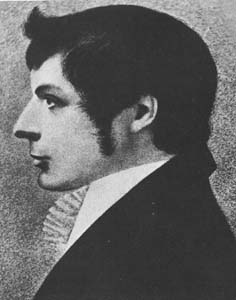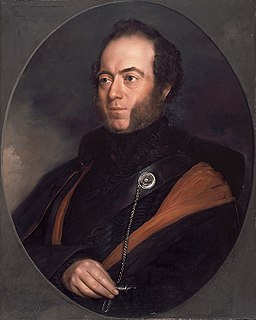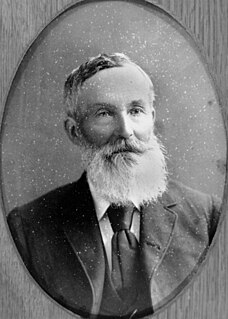Related Research Articles

John Joseph William Molesworth Oxley was an explorer and surveyor of Australia in the early period of British colonisation. He served as Surveyor General of New South Wales and is perhaps best known for his two expeditions into the interior of New South Wales and his exploration of the Tweed River and the Brisbane River in what is now the state of Queensland.

Sir Thomas Livingstone Mitchell, surveyor and explorer of Southeastern Australia, was born at Grangemouth in Stirlingshire, Scotland. In 1827 he took up an appointment as Assistant Surveyor General of New South Wales. The following year he became Surveyor General and remained in this position until his death. Mitchell was knighted in 1839 for his contribution to the surveying of Australia.

John Septimus Roe was the first Surveyor-General of Western Australia. He was a renowned explorer, a member of Western Australia's legislative and executive councils for nearly 40 years, but also a participant in the Pinjarra massacre on 28 October 1834.

John McDouall Stuart, often referred to as simply "McDouall Stuart", was a Scottish explorer and one of the most accomplished of all Australia's inland explorers.

Sir Augustus Charles Gregory was an English-born Australian explorer and surveyor. Between 1846 and 1858 he undertook four major expeditions. He was the first Surveyor-General of Queensland. He was appointed a lifetime Member of the Queensland Legislative Council.

George William Evans was a surveyor and early explorer in the Colony of New South Wales. Evans was born in Warwick, England, migrating to Australia in October 1802.
The Glenelg River is a river in the Kimberley region of Western Australia.
The following lists events that happened during 1838 in Australia.

Francis Thomas "Frank" Gregory was an Australian explorer and politician.
Charles Cooke Hunt was an English explorer who led four expeditions into the interior of Western Australia between 1864 and 1866.

Walcott Inlet is an estuary located in the Kimberley region of Western Australia. It flows into Collier Bay, in the Indian Ocean, via a narrow gap known as Yule Entrance.
The Berckelman River is a river in the Kimberley region of Western Australia.
The Sale River is a river in the Kimberley region of Western Australia. The river was seen and named on 9 June 1865 by an expedition from the short-lived Camden Harbor settlement searching for pastoral land. The expedition comprised Alexander McRae, Trevarton Sholl, PC William Gee, John Stainer and an Aboriginal constable named Billy.

George Augustus Frederick Elphinstone Dalrymple was a colonist, explorer, public servant and politician, member of the Legislative Assembly of Queensland. He founded the towns of Bowen and Cardwell, and pioneered the opening up of the Herbert, Burdekin, Johnstone and Daintree River regions to British colonisation.

Robert John Sholl was a government administrator, magistrate, explorer, journalist, entrepreneur, harbourmaster, customs official, postmaster and lay reader in Western Australia (WA), during the colonial era. Because of his multiple, simultaneous roles, which carried judicial, political, cultural and commercial power and influence, Sholl is regarded as a significant figure in the history of North-West Australia, at an early stage of its settlement by Europeans.
John Hill was an English explorer of South Australia and part of the European exploration of Australia. Hill was the first European to see and traverse the Clare Valley.
Camden Harbour was a short-lived settlement in the Kimberley region of Western Australia in 1864–1865 that was situated in the larger Camden Sound. The settlement was also known as the Camden Harbour Expedition, as well as the Government Camp.
Edwin Stow Berry was a surveyor and explorer, who took a leading part in two important expeditions to the Northern Territory of Australia.
Trevarton Charles Sholl was an explorer of North-West Australia and government official. During the 1860s, he undertook expeditions to the regions known later as the Kimberley and Pilbara. In March 1867, at the age of 21, Sholl was lost at sea and presumed dead, when the schooner Emma disappeared, during a storm.
Forlorn Hope was the name given by a group of seven men to an open boat in which they sailed and rowed from Adam Bay, Northern Territory to Champion Bay, Western Australia, a distance of some 2,000 miles (3,200 km) in May–August 1865.
References
- ↑ "Bonzle Digital Atlas - Map of McRae River, WA". 2011. Retrieved 10 July 2016.
- ↑ Cowle, James (26 September 1865). "Explorations in the Camden Harbour District: Report of an Expedition South of the Glenelg, by Assistant Surveyor Cowle, North District, 2nd May 1865". The Inquirer & Commercial News. p. 2. Retrieved 26 July 2012.
Coordinates: 16°46.254′S124°53.821′E / 16.770900°S 124.897017°E